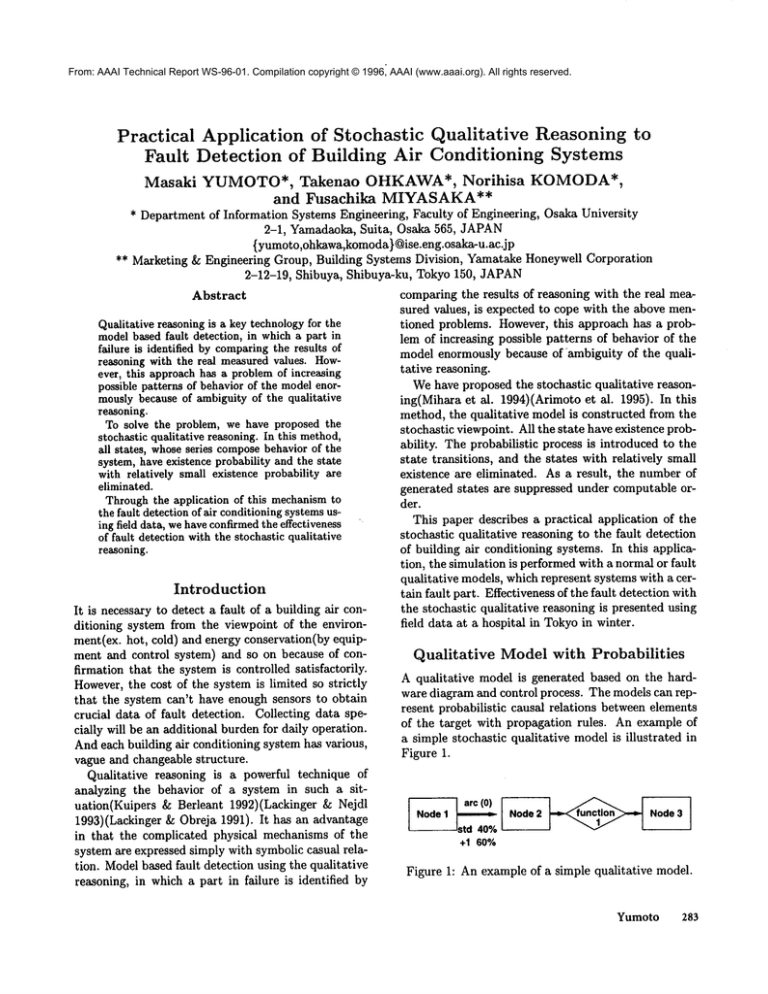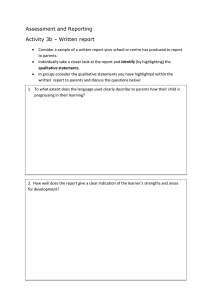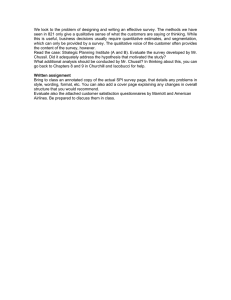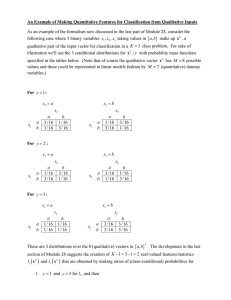
From: AAAI Technical Report WS-96-01. Compilation copyright © 1996, AAAI (www.aaai.org). All rights reserved.
Practical Application of Stochastic Qualitative Reasoning to
Fault Detection of Building Air Conditioning Systems
Masaki
YUMOTO*,
Takenao
OHKAWA*, Norihisa
KOMODA*~
and Fusachika
MIYASAKA**
* Department of Information Systems Engineering, Faculty of Engineering, Osaka University
2-1, Yamadaoka, Suita, Osaka 565, JAPAN
{yumoto,ohkawa,komoda}@ise.eng.osaka-u.ac.jp
** Marketing & Engineering Group, Building Systems Division, Yamatake Honeywell Corporation
2-12-19, Shibuya, Shibuya-ku, Tokyo 150, JAPAN
Abstract
Qualitative reasoning is a key technologyfor the
modelbasedfault detection, in whicha part in
failure is identified by comparingthe results of
reasoning with the real measuredvalues. However, this approach has a problemof increasing
possible patterns of behavior of the modelenormouslybecause of ambiguity of the qualitative
reasoning.
To solve the problem, we have proposed the
stochastic qualitative reasoning. In this method,
all states, whoseseries composebehavior of the
system, have existence probability and the state
with relatively small existence probability are
eliminated.
Throughthe application of this mechanismto
the fault detection of air conditioningsystemsusing field data, wehaveconfirmedthe effectiveness
of fault detection with the stochastic qualitative
reasoning.
Introduction
It is necessary to detect a fault of a building air conditioning system from the viewpoint of the environment(ex, hot, cold) and energy conservation(by equipment and control system) and so on because of confirmation that the system is controlled satisfactorily.
However,the cost of the system is limited so strictly
that the system can’t have enough sensors to obtain
crucial data of fault detection. Collecting data specially will be an additional burden for daily operation.
Andeach building air conditioning system has various,
vague and changeable structure.
Qualitative reasoning is a powerful technique of
analyzing the behavior of a system in such a situation(Kuipers & Berleant 1992)(Lackinger & Nejdl
1993)(Lackinger & Obreja 1991). It has an advantage
in that the complicated physical mechanisms of the
system are expressed simply with symbolic casual relation. Modelbased fault detection using the qualitative
reasoning, in which a part in failure is identified by
comparing the results of reasoning with the real mensured values, is expected to cope with the above mentioned problems. However, this approach has a problem of increasing possible patterns of behavior of the
model enormously because of ambiguity of the qualitative reasoning.
Wehave proposed the stochastic qualitative reasoning(Mihara et al. 1994)(Arimoto et al. 1995). In
method, the qualitative model is constructed from the
stochastic viewpoint. All the state have existence probability. The probabilistic process is introduced to the
state transitions, and the states with relatively small
existence are eliminated. As a result, the number of
generated states are suppressed under computable order.
This paper describes a practical application of the
stochastic qualitative reasoning to the fault detection
of building air conditioning systems. In this application, the simulation is performed with a normal or fault
qualitative models, which represent systems with a certain fault part. Effectiveness of the fault detection with
the stochastic qualitative reasoning is presented using
field data at a hospital in Tokyoin winter.
Qualitative
Model with
Probabilities
A qualitative model is generated based on the hardware diagram and control process. The models can represent probabilistic causal relations between elements
of the target with propagation rules. An example of
a simple stochastic qualitative model is illustrated in
Figure 1.
+1 60%
Figure 1: An example of a simple qualitative
model.
Yumoto
283
The qualitative model is constructed from nodes,
arcs with propagation rules, and functions.
destination node, "Node2", is still unchangedin probability of 0.4, otherwise, it changes one unit time later.
Nodes
Functions
Nodes correspond to the elements of a system. Each
node is characterized with some qualitative value as
shownin Table 1.
In case that a value of destination node is influenced
not by change of the source node but by the qualitative value itself, such a causal relation is expressed
with a function. A function receives qualitative values
of nodes as inputs, and gives change direction and its
probabilities as output. Three types of change direction on the function shown in Table 3 are prepared.
Table 4 shows an example of the definition of a function. Each change direction of the source node including its choosing probability is determined according to
the table.
Table 1: Qualitative value of temperature.
Qualitative
value
A
B
C
D
E
Interpretation
extremely hot
hot
normal
cold
extremely cold
Definition
24oC ,~
23oc N 24oC
22oC ,,, 23oC
21oC ,.~ 22oC
,,~21oC
There are some components whose values are measured by the sensors. These elements are expressed
with measured nodes, which make the use of decreasing the ambiguity of the qualitative reasoning.
Arcs with
the propagation
Table 2: Types of propagation rules.
-.I-1(-1)
std
If the source node of the arc changes,
the destination node changes in the same
(opposite) manner of the source node two
unit time later.
If the source node of the arc changes,
the destination node changes in the same
(opposite) manner as the source node one
unit time later.
If the source node of the arc changes,
the destination node is still unchanged.
In Figure 1, for example, the arc (0) has two propagation rules, (std) and (+1). Choosing probabilities
of them are 0.4 and 0.6 respectively. If the qualitative value of the source node of the arc, namely, "Node
1", changes in this model, the qualitative value of the
284
QR-96
Up
Down
Const
rules
An arc connects two nodes. The direction of an arc
implies the direction of the propagation of influence.
Propagation rules are attached on an arc. Five types
of the propagation rules shownin Table 2 are prepared.
More than one propagation rules are often attached to
an arc. In this case, each rule has a choosing probability which indicates the probability of the rule being
applied.
-{-2(-2)
Table 3: Types of change direction on the function.
The value of destination node
increase.
The value of destination node
decrease.
The value of destination node
is unchanged
Table 4: An example of a definition of function.
Input
Set
temp.
A
B
C
D
E
Stochastic
Up
0
0
10
20
4O
Output
Prob.(%)
[ Const. [ Down
6O
4O
8O
2O
8O
10
8O
0
6O
0
Qualitative
Reasoning
The stochastic qualitative reasoning is excused by a
series of recursive state transition in the qualitative
model. A state of a system on the qualitative model is
defined as a set of qualitative values of all node in the
model. Whenthe qualitative values of nodes 1,2 and
3 in Figure 1 is respectively B, B, C, the state of this
modelis expressed as [ B, B, C ].
An example of a state transition of the model in
Figure 1 is shown in Figure 2. Each state has an existence probability. The existence probability of each
new state is calculated based on the existence probability of the previous state and choosing probability of
Node1
The existence probability of each new state, which
has not discarded, is normalized to makethe total
of the existence probability of the state equal to
1.0. The normalized state is regarded as a new
current state of the next stage and the step 1 is
performed again until final stage.
Node2 Node 3
C
[ S
B
C
exlstance 1.0
probability
]
rule : std
func.: const.
, [ B B C ]
rule : std 1.0x0.4x0.8=0.32
func. : down
,. [ B B C ]
1.0 x 0.6 x 0.8 = 0.48
rule : up
func.: const.
¯ [ B A D ]
1.0 x 0.4 x 0.2 = 0.08
rule : up
func. : down
-- [ B A D ]
1.0 x 0.6 x 0.2 = 0.12
Figure 2: An example of state transition.
the applied rules and functions. The existence probability of the initial state is 1.0.
The basic procedure of the stochastic qualitative reasoning is summarizedas follows.
Step 1. Generation of the state
All propagation rules and functions are applied to
the current state, and then all possible states are
generated and the existence probabilities of them
are calculated.
Step 2. Elimination of the states
existence probability
with the small
The state is sorted in order of the existence probability. Each of the probability is added in order
until the sum arrives at the predefined threshold.
Then, all of remaining states are eliminated.
Step 3. Discard of the state that cannot agree with
the measured value
If the qualitative value of the measured node in a
new state is different from the measurement, the
state is discarded.
Step 4. Normalization of the existence probability
In the step 3, ’threshold’, which is predefined parameter, expresses the maximumsum of the existence
probabilities. The state elimination by the threshold
has been introduced in order to avoid consumingenormous execution time and large memoryin generating
all possible states. The lower ’threshold’ is supplied,
the more roughly but the more quickly simulation is
executed.
For further details of the algorithm, see the reference(Arimoto et al. 1995).
Figure 3 shows a sample of simulation practice.
First, ten states are generated based on the initial state
SO in the Step1. The sum of those states’ existence
probabilities is 1.0. Next, in the Step2, the states are
sorted in order of their existence probability. After the
sum of probabilities reached 0.7, which is a predefined
threshold, remaining states,namely, $1, $4, $7, $9 and
$10, are eliminated. $6 and $2, which are disagreed
with the real measured values pattern, are discarded
in the Step3. Since $3 and $5 are the same states,
they are unified into one state $3’ and their existence
probabilities are added. In the Step4, existence probabilities of survived states $3’ and $8 are divided by the
sum of them, namely, 0.42. Then those states become
the next current states, and simulation is continued.
In the simulation step 3, the states which cannot
agree with the measurements are discarded. If most of
the new states are discarded, we cannot consider that
the state transition reflects the real behavior of the
target well. On the other hand, if most of the states
are survive, we can conclude that the state transition
reflects the real behavior well. Wehave introduced
the evaluation parameter that can estimate the degree
of agreement of the simulation result with the measured behavior, named the agreement rate, based on
this idea.
The definition of the agreement rate Ra is shownas
follows.
1
Ro =
( 1×P2×
...
^
p,
!
n
0
In this expression, Pi means the sum of existence
probabilities of the states after the elimination of step
Yumoto
285
Procedure
Step
~xistence
controlled appropriately based on the set value and
measured values at sensors in the room, etc. Figure 4
showsan outline of it. Figure 5 illustrates the qualitative model of a building air conditioning system.
In this model, ’measured room temp.’ are measured
by thermometers.
~~.~~ability
0.10 0.12 0.15
0.05 0.15 0.03 0.03
measurement
¯ 0.15
~)
, 0.15 ~.12
temp.
measurement
~,.0.17 0.15 0.15 0.12 ~12 0.10 0.08 0.05 0.03 0.03
Threshold= 0.7
~.17
.room
[°..r.--J
room temp.
(~)
W
/L:.12
:
air temp.
temp.
control
@
0.27
Thecurrentstates
of the nextstage ~-~
~
T
0.15
Figure 4: An outline of air conditioning system.
2, and ~ means the sum of existence probabilities of
the states that are survived in the step 3 at the ith cycle of the simulation process, n is the number of
cycles of the simulation(the simulation time), and
means the threshold value.
The value of the agreement rate Ra is an indicator
showing how consistent that model was with the series
of measuredvalues if any state subsisted until the last
step. The higher this value, the higher the possibility
of the behavior represented by the simulation model.
If there is no survived state at a simulation cycle, the
value of the agreement rate Ra is calculated as zero
and the simulation is terminated.
Detection
of Building
Air
Condition
System
Qualitative
Model of Building Air
Conditioning
System
A building air conditioning system aims at keeping
temperature of rooms at a set value by supplying
warmed or cooled air. Temperature of supply air is
286
QR-96
I
//~0.~6
Figure 3: Simulation process.
Fault
heal load
(man, OA-machine,etc)
Overview of Fault Detection
Normal qualitative model is generated based on the
hardware diagram of an air conditioning system and
its control process. If the system has a fault, the fault
model is constructed by modifying the normal model
according to the fault part. In Figure 4, for example, if
’controller’ is the fault part of the system, the function
’h_2’ of the normal model is modified.
The simulation on an assumption of a fault is performed with the fault model and measured values. If
the agreement rate on the simulation of a fault model
becomes the highest in all models, an assumed fault
part in this fault model can be considered as a cause
of the fault.
Field Data
The data used for this study consists of complaint data,
the records on the dates and time, locations, and phenomenaof the complaint at a certain hospital in Tokyo
in winter from November11 in 1994 to April 30 in 1995.
And the on-line data which show temperatures every
ten minutes at 430 points in a hospital, where about
60 air conditioning systems had been in operating, had
been also gathered for the same term.
Table 5 shows complaint and hardware failure in the
field. An air-conditioner failure occurred only once
*rom
,.o,
I
m
ird
I
I:;Is0
s°%®
I
real
air
supply
~
real
room
temp.
temp.
g_l : 1-argument
disturbance function
h_2 : 2-argument
control function
I
f_3 : 3-argument
heat propagation function
reaourse
I
heat|
Figure 5: Qualitative ’1 room’ model of a building air condition system.
Nov.,
Dec.,
Jan.,
Feb.,
Mar.,
Apr.,
Total
Table 5: Complaint and hardware failure in the field.
Room temp.
Anemometer
Alarm
Cool
Warm
Humi.
Noise
Overl Over IDraft I Low
1
4
1
6
2
1
1
6
6
3
2
4
2
5
1
4
4
1
1
31
14
5
1
1994
1994
1995
1995
1995
1995
whenthe inverter circuit fuse blew out. Since the system was switched to air-conditioner by-pass operation
immediately, the problem was not reflected to the measured data. A complaint is made once every 3.5 days.
Complaints concerning temperature account for more
than 80 % of the total.
Through the stochastic qualitative simulation with
these field data, we show some examples of the fault
detection of the systems.
Fault Detection
"Cold"
for
Complaint
of "Hot"
or
In this study, the stochastic qualitative model shown
in Figure 5 is applied to fault detection of a certain
building air conditioning system.
Case 1: Deviation between a set value and
room temperature is large
Complaint "cold" occurred in a west sickroom on
the sixth floor of the hospital at 14:30 on November
3 in 1994, when set and measured temperatures have
changed as Figure 6. Fault detection by the stochastic qualitative reasoning was performed with the data
from 12:40 till 14:20. The qualitative values of the
temperatures are defined as Table 6. Table 7 shows
Hardware
Trouble
1
Total
13
10
9
8
6
8
54
1
the agreement rate, which was obtained as the result
of the qualitative reasoning for every fault model.
The agreement rate of the thermometer fault model
remained because no change in the room temperature
was observed. This can be interpreted that the fine
coil is turned off or its capacity is insufficient or the
temperature setting of the mr conditioner is low.
temp. (°C)
28
: set room tamp.
: measured room tamp.
26
¯
: measuredtime
24
/
22
20
:..tD...e...o..o..~...e...o..o...e...o..o..
t .................
18
I
I
I I
13:00
I
I
I
I
I I
14:00
I
complaint
I i i i ~
15:00
time
Figure 6: Set and measured temperature transition
the sickroom on Nov. 3.
Yumoto
at
287
Table 6: Qualitative value of Case 1,2.
Room temp.
Qualitative
Heat resource
value
Supply air temp.
24°C~
A
extremely hot
B
23oC,,,24oC hot
22oC,.~23oC normal
C
D
21oC,~ 22oC
cold
E
~ 21oC
extremely cold
temp. (°C)
28
26 -24
.e...e...o..o..o...e-..o-.o...o...o..4).... \ ~ ........
--
22 -
complaint
2O
18
Table 7: Agreement rate with measured values on Nov.
3.
Fault
Threshold
model
0.7
0.6
0.5
Normal
0.000
Control system
Failure
Control valve
adhere
Room Thermometer
Failure
SupplyAir
SystemFailure
Strong Bias
against Load
0.000
0.000
0.507
0.507
0.515
0.896
0.915
0.980
0.000
Case 2: Deviation between a set value and
room temperature
is small
In the same system as ’Case 1’, complaint "hot"
occurred in the sickroom at 19:00 on November 13
in 1994, when set and measured temperatures have
changed as Figure 7. Fault detection by the stochastic qualitative simulation was performed with the data
from 17:10 till 18:50. The qualitative values of the
temperatures are defined as Table 6. Table 8 shows
the agreement rate.
The reminded models are the normal, the control
failure, control valve adhere, and room thermometer
failure model. Since no change in the room temperature is observed like ’Case 1’, the thermometerfailure
cannot be erased in Table 8. In this simulation, the deviation between a set value and the room temperature
is too small to classify the normal, the control failure,
and control valve adhere.
288
QR-96
I
17:00
~ I
I
I I
18:00
I
I
I
I
1 I
19:00
I
I_
time
Figure 7: Set and measured temperature transition
the sickroom on Nov. 13.
at
Table 8: Agreement rate with measured values on Nov.
13.
Fault
Threshold
model
0.7
0.6
0.5
Normal
0.638
0.631
0.668
Control system
Failure
Control valve
adhere
Room Thermometer
Failure
Supply Air
System Failure
Strong Bias
against Load
0.638
0.631
0.668
0.638
0.631
0.668
0.521
0.509
0.527
0.000
0.000
Case 3: Air-Conditioner
is Started
Out-patient
Department
in
Ordinarily, the air-conditioner for the out-patient
department is started 30 minutes before the service for
out-paints begins. It does not reach the set temperature when a complaint "cold" occurred in the room
at 9:50 on Dec. 21 in 1994. Set and measured temperature changed as Figure 8. Figure 9 shows a typical state when no complaint occurred during the same
time. The general trend is that no complaint occurs
when the room temperature becomes 23 °C or higher
by around 10 o’clock. On the other hand, a complaint
of "hot" was occurred at the room temperature of 25
°C at 14:30 on January 26.
Table 10: Agreement rate with Measured values on
Dec. 21.
Threshold
Fault
model
0.7
0.6
0.5
Normal
0.000
temp. (Oc)
: set room temp.
28
: measured room temp.
: measured time
28
24
22
2O
............
¯ ..0...¯..0..0...e...0..." i"complaint
b "¯"
18
I
I
I
I
8:00
I
I
I
I
I
I
!
I~
10:00
time
9:00
Figure 8: Set and measured temperature transition
the room for out-paint on Dec. 21.
temp.
at
: set room temp.
...........
0.302
0.000
0.000
0.000
O.530
0.000
0.490
0.286
0.000
0.000
Table 11: Agreement rate with Measured values on
Jan. 9.
Fault
Threshold
model
0.7
0.6
0.5
Normal
0.374
0.385
0.299
°c )
28
Control system
Failure
Control valve
Failure
Room Thermometer
Failure
Supply Air
System Failure
Heat Propagation
delay
Strong Bias
against Load
: measuredroomtemp.
: measured time
26
24
22
,r..¯..¯...o.-o"
20
¯ e...r’¯
.................
18
IIII
8:00
[illllll~
9:00
10:00
time
Figure 9: Set and measured temperature transition
the room for out-paint on Jan 9.
Table 9: Qualitative value
Room temp.
Qualitative
Supply air temp.
value
27oC
A
25oC,.,27oC
B
23oC,,~25oC
C
21oC,.~23oC
D
,,.21oC
E
of Case 3.
Heat resource
extremely hot
hot
normal
cold
extremely cold
at
Control system
Failure
Control valve
Failure
Room Thermometer
Failure
Supply Air
System Failure
Heat Propagation
delay
Strong Bias
against Load
0.380
0.000
0.000
0.000
0.000
0.000
0.513
0.493
0.526
The qualitative models are illustrated by Figure 5.
Twonew fault models were added. One is a heat propagation delay model which was developed in consideration of the delay due to the heat capacity of the building at the time of starting up. The other is an overload
model. Table 9 shows the definition of the qualitative
values.
Table 10 and 11 show the agreement rate as the simulation results. In Table 10, "Heat Propagation delay"
takes the highest agreement rate of all. As a result, we
can infer that the system had no failure but was not
able to warmso quickly.
Yumoto
289
l
measured ]
Iupplyair temp.
I set supply
I air temp.
_~_
- "~-...~-~.,,~ -
=
g_l : 1-argument
disturbance
function
h_2 : 2-argument
controlfunction
f 3 : 3-argument
- heat propagationfunction
I
real room
temp.
heat
I
resourse ] :
I
I
Figure 10: Qualitative model of Air conditioner.
Detection
of Control
System Failure
Hunting of supply air temperature has been observed
though this did not lead to any complaint during the
period covered for the present study. A certain system
shows hunting almost everyday.
The air conditioner for the general treatment department shows hunting of 2 - 4°C at a cycle of 20 - 30
minutes, while air conditioner for the animal house
shows hunting of 4°C at a cycle of 2 hours. A complaint of "cold" was occurred in a certain out-patient
department at 9:50 on Dec. 21, 1994. Wetried to detect hunting using the data of the air conditioner for
the general department at this time. Figure 10 shows
the qualitative model, and Table 12 shows the definition of the qualitative values. Table 13 shows the
agreement rate as simulation results. And Table 14
showsthe measuredvalues and their qualitative values.
Qualitative reasoning seems to be especially useful for
catching such a hunting phenomenon.
Table 13: Agreement rate with Measured values under
various model.
Threshold
Fault
model
0.7
0.6
0.5
0.250
0.000
Normal
Control system
Failure
Control valve
Failure
Room Thermometer
Failure
Supply Air
System Failure
I
290
QR-96
0.239
0.000
0.000
0.000
0.000
Table 14: A sequence of Measured value and Qualitative value.
Time
Table 12: Qualitative value to detection of control system.
Qualitative
Room temp. J Heat resource
Supply air temp.
value
22oC,.,
extremely hot
A
21oC,,~ 22oC hot
B
20oC,.,., 21oC normal
C
19oC,,.20oC cold
D
,,~19°C extremely cold
E
0.259
Step
0
1
2
3
4
5
6
7
8
Measured Value
of Supply temp.
measure- qualitative
ment
value
B
21.7
21.2
B
22.6
A
21.3
B
22.8
A
21.3
B
21.8
B
20.9
C
20.1
C
"C
20.4
20.8
C
Set Value
of Supply temp.
measure- qualitative
ment
value
20.0
C
20.0
C
20.0
C
20.O
C
20.0
C
20.0
C
2O.O
C
20.0
C
20.O
C
20.0
C
20.0
C
Conclusion
This paper reported that the fault detection of air conditioning systems was well achieved by the stochastic qualitative reasoning using the practical field data.
Weplan to conduct researches on the sensitivity analysis and the automatic model construction to develop
practical qualitative reasoning programs(Yumotoet al.
1996). Wewill continue to perform the fault detection
of the other target such as heat source.
A fault detection program based on qualitative reasoning will be useful for testing and adjusting the airconditioning system of a building whenit is completed.
References
Kuipers, B., and Berleant, D. 1992. Qualitativenumeric simulation with Q3. Recent Advances in Qualitative Physics, The MIT Press.: 3-16
Lackinger, F., and Nejdl, W. 1993. Diamon: A modelbased troubleshooter based on qualitative reasoning.
IEEE Expert, vol.8, no.1:33-40
Lackinger, F., Obreja, I. 1991. Model-based troubleshooting of complex technical systems using integrated qualitative techniques. In Proc. of AI, Simulation and Planning in High AutonomySystem:122-129
Mihara, K., Aono, Y., Ohkawa, T., Komoda, N.,
Miyasaka, F. 1994 Stochastic qualitative reasoning and
its application to diagnosis of air conditioning system.
In Proc. of the IEEE Industrial Conference on Industrial Electronics, Control and Instrumentation ’94:
1401-1406
Arimoto, S., Mihara, K., Ohkawa, T., Komoda, N.,
Miyasaka, F. 1995. Real-time stochastic qualitative
simulation of large scale air conditioning system. In
Proc. of IEEE International Symposiumon Industrial
Electronics ’95:902-907
Yumoto, M., Ohkawa, T., Komoda, N., Miyasaka, F.
1996 to appear. An Approach to Automatic Model
Generation for Stochastic Qualitative Simulation of
Building Air Conditioning Systems. In Proc. of of
IEEE International Symposiumon Industrial Electronics ’96
Yumoto
291




